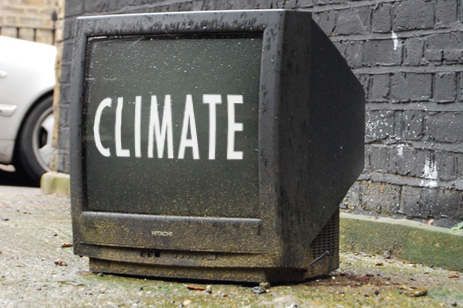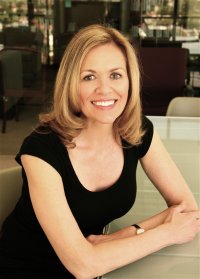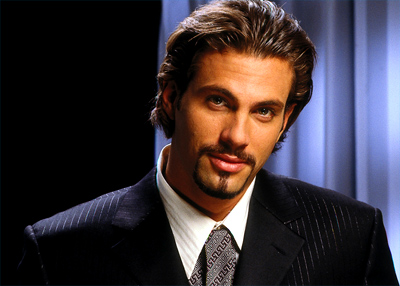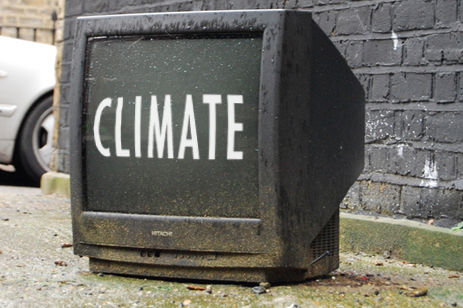 Original photo: Rob OxleyWhen the AIDS crisis first began, before the disease even had a name, the Centers for Disease Control (CDC) commissioned an analysis of the best way to get important new information out to the public. The answer that came back was clear: Hollywood. For better or worse, TV and movies have the widest and fastest access to the most Americans. Needless to say, that hasn’t changed in the years since.
Original photo: Rob OxleyWhen the AIDS crisis first began, before the disease even had a name, the Centers for Disease Control (CDC) commissioned an analysis of the best way to get important new information out to the public. The answer that came back was clear: Hollywood. For better or worse, TV and movies have the widest and fastest access to the most Americans. Needless to say, that hasn’t changed in the years since.
CDC’s insight eventually led to the establishment of Hollywood, Health, and Society (HHS), a project based in Los Angeles that works directly with screenwriters to increase the frequency and accuracy of health-related storylines in television, film, and new media. (The project was founded with money from the Lear Center and now receives additional funding from the Bill and Melinda Gates Foundation, the California Endowment, the National Cancer Institute, and several other government sources.)
The folks at HHS do not produce or write TV shows or movies. They don’t appear in the credits. They don’t do public advocacy or political lobbying. They work almost entirely behind the scenes, directly with writers, who come to them to make sure the health issues portrayed in their stories are accurate, or to get ideas for compelling stories based on real health problems.
Can you think of another issue that might benefit from being portrayed more often and accurately in mass entertainment? Me too. As it happens, HHS has a mandate from the CDC to expand into climate change. They just need some foundation funding to build up a program.
I called HHS director Sandra de Castro Buffington to talk about the model and how it might be extended.
——
 Sandra de Castro Buffington, director of Hollywood, Health and SocietyPhoto: The Norman Lear CenterQ. Tell us a bit about how Hollywood, Health, and Society works.
Sandra de Castro Buffington, director of Hollywood, Health and SocietyPhoto: The Norman Lear CenterQ. Tell us a bit about how Hollywood, Health, and Society works.
A. In the traditional approach, [public health agencies] produce or coproduce entertainment programs, which means they pay for them and have control from beginning to end. They have measurable impact, but the thing is, when you’re paying for it, they have to be short-lived. There’s never enough money; it’s extremely costly.
With Hollywood, Health, and Society, you flip the model on its head. We are a bridge between health experts and the entertainment industry. We don’t produce and we don’t coproduce. We don’t pitch storylines, because we recognize writers as the master storytellers of our times. We simply inspire and inform. There’s a big difference.
We have a huge database of experts who give their time, free of charge. We take them right into the writers’ rooms of major programs like House, Grey’s Anatomy, or Law and Order: Special Victims Unit. We prepare them very carefully before we go in. If I were to take a climate change expert in, I would coach him or her to start with a case study, a real story of a real person or real community. Personalize it, give them the grit of real life — that’s what [writers] are looking for. They’re so creative, they pick up on these topics and they’ll spin the story themselves.
Q. Do you do outreach or is it mostly writers coming to you?
A. We do both proactive outreach and what we call reactive, which is responding to inquiries. We get writers’ inquiries seven days a week.
Let’s start with the proactive aspect. We hold panel discussions at the Writers Guild of America West on a regular basis. I have a climate change panel discussion coming up on March 9, so I’m going to bring together a small group of experts, a keynote speaker, and some writers and/or producers who have successfully portrayed climate issues in television or film. They can talk about how they did it, why they did it, what were some of the challenges, what are some of the opportunities. We get about 75 to 100 writers at these events.
We have long-standing, trusting relationships with the writers, so if I have an expert in town, I’ll call them and say, look, I’ve got this amazing person who has real stories I’m sure you’ve never heard before. Can we have one hour on Friday?
Now, why do the writers trust us? They have every special interest group in the world hitting on them every day, but they don’t want someone else’s agenda being pushed on them. The reason they trust us is that we never push an agenda. We’re simply a free resource. We will get them an expert on any topic they want.
Q. What percentage of your work is proactive vs. writers coming to you?
A. The reason I can’t give you percentages is that this is very interactive. It might start as a briefing with an expert in the writers’ room, inspiring writers to address a topic; if it turns into a major storyline, they come back to us with inquiries. It’s much more than fact-checking, because we facilitate a lot of phone conversations, emails, questions, and answers. Every interaction with a writer is an opportunity to drop in another topic or point them in a new direction. It’s a dynamic, vital exchange.
Q. Having done this for almost 10 years now, would you say that health information presented in TV and movies these days is roughly accurate? Have you achieved your goal?
A. We measure the impact of major TV health storylines on viewers’ knowledge, attitudes, and behavior. We’re in an academic setting; we publish in peer-reviewed journals. That’s part of what we do.
Let me throw some numbers at you. We know from health surveys that nearly two-thirds of regular viewers of television report learning something new about a disease or how to prevent it from television shows; nearly one-third of those viewers report taking action on what they learned.
For example, we had an organ transplantation storyline on Numbers. Ten percent of viewers who viewed it the first time it aired signed up to become organ donors. They didn’t just talk about it; they actually signed up! So, we know people are taking action.
 Would you believe this man? Tony from The Bold and the BeautifulWe had a storyline about heterosexual transmission of HIV in The Bold and the Beautiful, which is the longest-running daytime soap in the world, aired in over a hundred countries around the world. Tony learns in one episode that he is HIV positive. In another, he tells his fiancée, Kristen, that he is positive. They get married, go to Africa, and adopt a baby.
Would you believe this man? Tony from The Bold and the BeautifulWe had a storyline about heterosexual transmission of HIV in The Bold and the Beautiful, which is the longest-running daytime soap in the world, aired in over a hundred countries around the world. Tony learns in one episode that he is HIV positive. In another, he tells his fiancée, Kristen, that he is positive. They get married, go to Africa, and adopt a baby.
Well, we asked the network: could we air a public service announcement at a dramatic plot point during the story? And they let us feature the lead actor, Tony, referring viewers to the CDC’s AIDS call-in hotline number. Then we tracked the traffic to that hotline number for a year.
The highest peak in calls all year, 5,313 calls in a single day, occurred the day Tony told his fiancée, Kristen, that he was HIV positive. 60 Minutes
did a segment; MTV did two specials; the surgeon general had a big campaign; there was a national, highly financed “Get Testing” campaign — nothing came close to The Bold and the Beautiful.
The most popular shows can reach up to 20 million viewers in one hour the first time they air, and most networks air them four times. Then they go to syndicated rerun, then overseas, the popular ones to over a hundred countries. They go on and on, are aired over and over.
Q. In addition to working with people beforehand, do you police for inaccurate information?
A. We have what’s called the HHS TV Monitoring Project. We’ve been collecting data for six years. We do health mapping of all the health content on the top 20 scripted shows for the January to May season every year, using Nielsen ratings. We code for over 70 different health topics, including the environment and climate change, every food consumed, every beverage consumed, age, ethnicity, everything.
I can tell you a trend. In 2004, 51 percent of all storylines on those top 20 scripted shows were health storylines. By 2006, over 60 percent were health storylines. By 2009, 80 percent. These are crime shows, comedies, dramas.
What’s most important here is the relationship with the writers, because even if they get it wrong once, if you have a relationship and continue to inspire, inform, and connect them with experts, they’ll eventually get it right. We’ve seen this over and over again. It doesn’t help to slap anyone’s hand. That’s not our job.
Q. To most Americans, climate change seems abstract and distant, very different from health, which is immediate and personally relevant. Can climate change be compelling in a dramatic setting?
A. Climate change is so compelling. Take it down to the individuals. Climate Refugees is a wonderful documentary by Michael Nash. It shows the human stories behind climate change.
That’s what writers are looking for — the human element. There are whole countries that are sinking. There’s a head of state traveling the world looking for a place to move his country. There are incredible health consequences as a result of global warming. Those are some of the things we can focus on because they impact individuals and communities.
One of our mandates from the California Endowment is to address the social determinants of health disparities. How do you get writers excited about how space and place impact people? It’s easier to focus on individual risk and behavior. But we’re doing it; we’ve had tremendous success. Some of the ways we inspire writers are setting up story bus tours, taking groups of writers into inner-city communities to meet local storytellers and hear them tell their own stories. We’re getting ready to take a group of writers overseas to developing countries, to Africa and Southeast Asia, so they have direct experience.
There are different ways of putting a more personal face on these issues. The challenge to the global climate change community is this: If you could reach up to 20 million people in one hour with three key messages, what would they be? For any expert in a field, that’s a challenge, because they know so much. We put these key message in a format the writers can use, along with a lot of background information.
You’d be surprised how many times the dialogue coming out of your favorite characters’ mouths comes directly from those three key messages we’ve provided. I hope the climate community can benefit from what we’ve learned.
Q. So you’re trying to expand into climate change?
A. I have a mandate this year from the CDC, one of our partners, to address climate change. I’m thrilled.
The main thing is we need funding from a climate group — it has to be a foundation or a government source, because we don’t take funding from any special interest groups — for me to really develop this into a full-blown program. We need climate change to be something that writers are addressing on a regular basis. If we had full funding and I could have a team focused on nothing but climate, that’s exactly what we’d see.
We have a lot of published papers on the effects of what’s called “transportation,” which is a measure of engrossment. We know that when viewers are transported by a storyline, they forget their surroundings, they lose track of time, they come to see characters as beloved family or friends, and they care deeply about what happens to them. In that state of transportation, they have much more openness to learning and much greater knowledge gains, attitude shifts, and shifts in behavioral intentions. They are much more likely to talk to someone about what they saw or learned. That’s why it is so much more effective to get these storylines woven in, instead of saying, “Let’s go out and teach somebody something.” There’s been a significant shift around public health. I predict the same thing will happen with climate change, if we get some momentum going.


